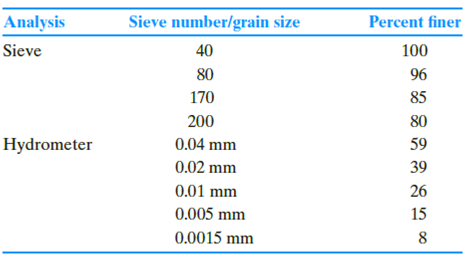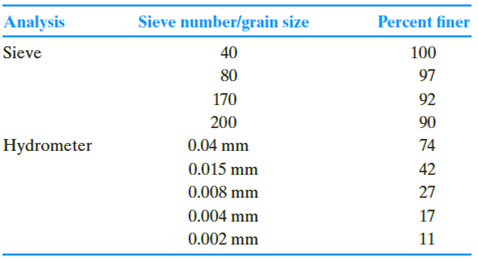
Principles of Geotechnical Engineering (MindTap Course List)
9th Edition
ISBN: 9781305970939
Author: Braja M. Das, Khaled Sobhan
Publisher: Cengage Learning
expand_more
expand_more
format_list_bulleted
Concept explainers
Textbook Question
Chapter 2, Problem 2.9P
Repeat Problem 2.8 using the following data.

2.8 The following are the results of a sieve and hydrometer analysis.

a. Draw the grain-size distribution curve.
b. Determine the percentages of gravel, sand, silt and clay according to the MIT system.
c. Repeat Part b according to the USDA system.
d. Repeat Part b according to the AASHTO system.
Expert Solution & Answer
Trending nowThis is a popular solution!

Students have asked these similar questions
How to determine horizontal displacement of a frame
H.W: Evaluate the integral:
√√2 3y 8-x²-y2
1.
!!!
00 x²+3y²
2.
dzdxdy
11-x 1
0 0 x+z
dydzdx
1
1 1
3. } } } α+y+
-1-1-1
(x + y + z)dydxdz
For the beam below, select stirrup spacings for #3 stirrups if f = 4,000 psi, normal
weight concrete and f, = 60,000 psi.
P₁ = 30 k
@L
OL =
3 k/ft
WD
2 k/ft (including beam weight)
/////////////
10 ft-
-20 ft-
-30 ft-
18 in.
24 in.
Chapter 2 Solutions
Principles of Geotechnical Engineering (MindTap Course List)
Ch. 2 - For a gravel with D60 = 0.48 mm, D30 = 0.25 mm,...Ch. 2 - Prob. 2.2PCh. 2 - Prob. 2.3PCh. 2 - The following are the results of a sieve analysis....Ch. 2 - Repeat Problem 2.4 with the following data. 2.4...Ch. 2 - Repeat Problem 2.4 with the following data. 2.4...Ch. 2 - Repeat Problem 2.4 with the following data. 2.4...Ch. 2 - The following are the results of a sieve and...Ch. 2 - Repeat Problem 2.8 using the following data. 2.8...Ch. 2 - Repeat Problem 2.8 using the following data. 2.8...
Ch. 2 - The grain-size characteristics of a soil are given...Ch. 2 - Repeat Problem 2.11 with the following data. 2.11...Ch. 2 - Repeat Problem 2.11 with the following data. 2.11...Ch. 2 - A hydrometer test has the following result: Gs =...Ch. 2 - Repeat Problem 2.14 with the following values: Gs...Ch. 2 - Three groups of students from the Geotechnical...Ch. 2 - Refer to Problem 2.C.1. Results of the sieve...
Knowledge Booster
Learn more about
Need a deep-dive on the concept behind this application? Look no further. Learn more about this topic, civil-engineering and related others by exploring similar questions and additional content below.Similar questions
- G-1 The drawing shows the beam (B) and girder (G) layout for the third floor of a commercial building. The live load (LL) for the flow is 45 PSF and the dead load (DL), which consists of a 4" thick concrete slab weighs 50 PSF. For now, we will neglect the weight of the beams/girders. 24 ft 6 ft 6 ft 6 ft 6 ft 6 ft G-2 C6 30 ft G-3 24 ft B-1 B-2 B-3 B-4 B-5 B-6 G-4 Compute the distributed loads applied on girder G-2. Show a FBD of these loads and compute the reactions at columns C2 and C6.arrow_forwardable to help me with the question below with references too for study purpose Structural InvestigationThe Building Maintenance and Strata Management Act 2004 interprets “Structural elements,for a building means an internal or external load-bearing component of the building or part ofthe building that is essential to the stability of the building but exclude any door or window.”Loading-bearing components such as wall, column or beam, etc, are subjected to externalforces. (a) Interpret the diagnosis of a structural defect and discuss FOUR (4) external forces ona structure element that may cause structural cracks.(b) Discuss the effects of alkali-silica reaction on concrete structures and formulateFOUR (4) preventive measures.(c) Discuss the differences between chloride attack and sulphate attack on concretestructures(d) Formulate preventive measures to prevent or reduce chloride and sulphate attack onconcrete structures Hard FinishesNatural timber flooring such as timber strips and…arrow_forwardFor the gravity concrete dam shown in the figure, (the vertical stresses at toe and heel ((Pmax & Pmin) are and 52 ton/m respectively. following data are available:- -Unit weight of concrete (yconc)-2.4 ton/m³ Solve on paper -Neglect Wave pressure, silt pressure, ice force and earth quake force. #=0.65 Find factor of safety against sliding and overturning (F.Sslid & F.Sover) Azo 115 m 120 marrow_forward
- For the gravity concrete dam shown in the figure, (the vertical stresses at toe and heel ((Pmax & Pmin) are and 52 ton/m respectively. following data are available :- -Unit weight of concrete (yconc) 2.4 ton/m³ -Neglect Wave pressure, silt pressure, ice force and earth quake force. #=0.65 Find factor of safety against sliding and overturning (F.Sslid & F.Sover) A36 115 m m 120 marrow_forwardA horizontal cantilever of effective length 3a, carries two concentrated loads W at a distance a from the fixed end and W' at a distance a from the free end. Obtain a formula for the maximum deflection due to this loading using Mohr's method. If the cantilever is 250 mm by 150mm steel I beam, 3 m long having a second moment of area I as 8500 cm4, determine W and W'to give a maximum deflection of 6 mm when the maximum stress due to bending is 90 Mpa. Take Young's modulus of material E as 185 Gpa.arrow_forwardFor the gravity concrete dam shown in the figure, (the vertical stresses at toe and heel ((Pmax & Pmin) are and 52 ton/m respectively. following data are available :- -Unit weight of concrete (yconc) 2.4 ton/m² -Neglect Wave pressure, silt pressure, ice force and earth quake force. #=0.65 Find factor of safety against sliding and overturning (F.Sslid & F.Sover) AS 115 m Sm 120 marrow_forward
- Must be handwrittenShow your complete solution with proper working equations.Express intermediate answers to at least four (4) decimal places and round final answers to two (2) decimal places. Enclose and summarize your final answers in a boxarrow_forward: For the gravity concrete dam shown in the figure, the following data are available: The factor of safety against sliding (F.S sliding)=1.2 Unit weight of concrete (Yconc)=24 KN/m³ - Neglect( Wave pressure, silt pressure, ice force and earth quake force) μ=0.65, (Ywater) = 9.81 KN/m³ Find factor of safety against overturning (F.S overturning) 6m3 80m Smarrow_forwardAum AA waste incinerator stack emits 27,027 kg/yr of cadmium and has an effective stack might of 100 m. The wind speed is 5 m/s at an anemometer located at 10 m. It is a clear sunny day with the sun nearly overhead (Class B conditions). a. Calculate the ground-level cadmium concentration (in ug/m³) at a distance of 2 km directly downwind? [Refer to tables in the textbook to help with this problem] What is the concentration of cadmium (in µg/m³) inside of a house at the location in part (a) after two hours? Note that the initial concentration of cadmium in the house was zero, there are 0.25 air changes per hour (ach), there is no source of cadmium inside the house, and cadmium is considered a conservative pollutant.arrow_forward
- Must be handwrittenShow your complete solution with proper working equations.Express intermediate answers to at least four (4) decimal places and round final answers to two (2) decimal places. Enclose and summarize your final answers in a boxarrow_forwardFor the frame shown below, determine the vertical displacement at C. Assume that flexural rigidities AB and BC segments are EI and 2EI, respectively. Use the method of virtual work and show all working.arrow_forwardYou are an engineer designing an aeration tank for a wastewater treatment plant receiving municipal waste. The activated sludge system (aeration tank and secondary clarifier) you design needs to remove 85% of the incoming BODs from the primary effluent, giving a final concentration of 30.0 mg BOD5/L exiting the system. Your design will maintain a concentration of 2500 mg VSS/L and F/M ratio of 0.5 g BOD/g VSS d in the aeration tank. In an effort to keep the waste activated sludge low in water, only about 0.1% of the primary effluent flow (Q) exits the WAS line. The secondary effluent has a flow rate of 9990 m³/d. What volume (in m³) will the aeration tank need to be? Write out all equations and state any assumptions as needed. Primary effluent: Aeration tank V, X, S Secondary clarifier Secondary effluent: Q. Xo. So Qe, Xe, S 0 po RAS line: Q, X., S Activated sludge control volume WAS line: Qw, X, Sarrow_forward
arrow_back_ios
SEE MORE QUESTIONS
arrow_forward_ios
Recommended textbooks for you
 Principles of Geotechnical Engineering (MindTap C...Civil EngineeringISBN:9781305970939Author:Braja M. Das, Khaled SobhanPublisher:Cengage Learning
Principles of Geotechnical Engineering (MindTap C...Civil EngineeringISBN:9781305970939Author:Braja M. Das, Khaled SobhanPublisher:Cengage Learning Principles of Foundation Engineering (MindTap Cou...Civil EngineeringISBN:9781337705028Author:Braja M. Das, Nagaratnam SivakuganPublisher:Cengage Learning
Principles of Foundation Engineering (MindTap Cou...Civil EngineeringISBN:9781337705028Author:Braja M. Das, Nagaratnam SivakuganPublisher:Cengage Learning Fundamentals of Geotechnical Engineering (MindTap...Civil EngineeringISBN:9781305635180Author:Braja M. Das, Nagaratnam SivakuganPublisher:Cengage Learning
Fundamentals of Geotechnical Engineering (MindTap...Civil EngineeringISBN:9781305635180Author:Braja M. Das, Nagaratnam SivakuganPublisher:Cengage Learning Construction Materials, Methods and Techniques (M...Civil EngineeringISBN:9781305086272Author:William P. Spence, Eva KultermannPublisher:Cengage Learning
Construction Materials, Methods and Techniques (M...Civil EngineeringISBN:9781305086272Author:William P. Spence, Eva KultermannPublisher:Cengage Learning Traffic and Highway EngineeringCivil EngineeringISBN:9781305156241Author:Garber, Nicholas J.Publisher:Cengage Learning
Traffic and Highway EngineeringCivil EngineeringISBN:9781305156241Author:Garber, Nicholas J.Publisher:Cengage Learning Principles of Foundation Engineering (MindTap Cou...Civil EngineeringISBN:9781305081550Author:Braja M. DasPublisher:Cengage Learning
Principles of Foundation Engineering (MindTap Cou...Civil EngineeringISBN:9781305081550Author:Braja M. DasPublisher:Cengage Learning

Principles of Geotechnical Engineering (MindTap C...
Civil Engineering
ISBN:9781305970939
Author:Braja M. Das, Khaled Sobhan
Publisher:Cengage Learning

Principles of Foundation Engineering (MindTap Cou...
Civil Engineering
ISBN:9781337705028
Author:Braja M. Das, Nagaratnam Sivakugan
Publisher:Cengage Learning

Fundamentals of Geotechnical Engineering (MindTap...
Civil Engineering
ISBN:9781305635180
Author:Braja M. Das, Nagaratnam Sivakugan
Publisher:Cengage Learning

Construction Materials, Methods and Techniques (M...
Civil Engineering
ISBN:9781305086272
Author:William P. Spence, Eva Kultermann
Publisher:Cengage Learning

Traffic and Highway Engineering
Civil Engineering
ISBN:9781305156241
Author:Garber, Nicholas J.
Publisher:Cengage Learning

Principles of Foundation Engineering (MindTap Cou...
Civil Engineering
ISBN:9781305081550
Author:Braja M. Das
Publisher:Cengage Learning
How Are Highways Designed?; Author: Practical Engineering;https://www.youtube.com/watch?v=9XIjqdk69O4;License: Standard Youtube License